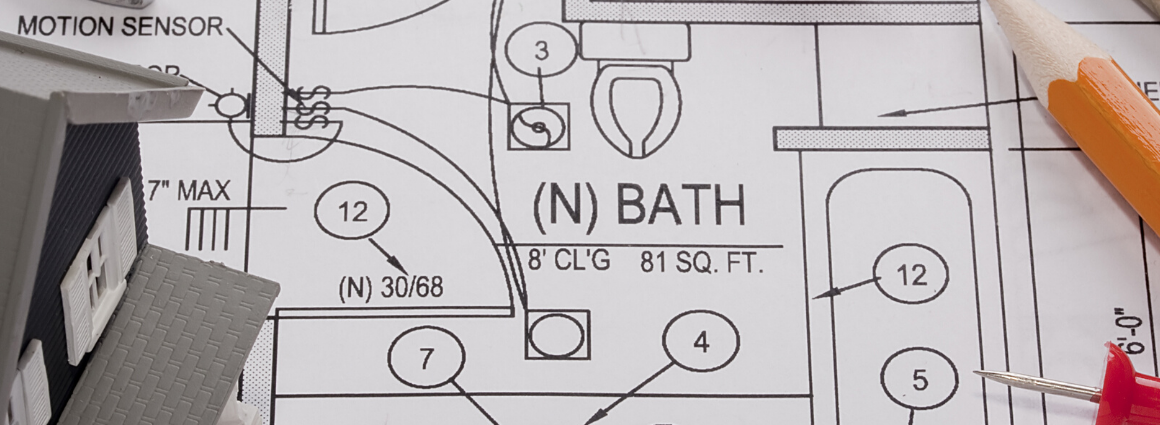Planning a Bathroom Remodel in Northern Virginia
Are you looking to remodel your bathroom in Northern Virginia? Having worked in interior design and remodeling homes in the area for the past twenty-five years I have come to find that there are so many aspects and nuances around a remodel, especially when we’re talking about bathrooms and kitchens. Along with the kitchen, it is the room that realtors consider most critical in establishing the market value of a home. These two spaces are the most crucial to have updated, add the most value to your home, and are spaces where you spend a significant amount of time. Each type of project takes specific know-how and in this blog, I will walk you through all of the elements of remodeling a bathroom and the specifics that are useful for homes located in Northern Virginia.
In this guide, we will walk through a brief history of bathrooms, the steps to consider when you are looking to renovate your bathroom, trends we’re seeing in bathroom remodels in Northern Virginia, and resources available to people looking to renovate their bathrooms here. With that, let’s dive in!
A Brief History on Bathrooms:
Before we jump into the specifics, it’s important to have the background needed to understand our topic! Bathrooms have evolved significantly over the years. Once relegated to a minor role in the design scheme of the home, the bath has now emerged as a pivotal room in the design of most residences.
Previously
Remember, however, that the bathroom, as we know it, is a relatively recent phenomenon. It wasn’t until the middle of the 19th century that people even had access to centrally supplied water. Until then, water had to be brought by hand from a well or pump. With a few notable exceptions in our area, such as the bath in Baltimore’s Evergreen House, built in the 1850s bathrooms were never the site of significant architectural or design interest.
The 20th century introduced hot running water to our household, and new manufacturing technologies enabled companies like Kohler and American Standard to supply our homes with the bathtubs, sinks, and toilets that would come to be the foundation of the modern bathroom. But in creating this new space, design and architectural nuances continue to play a secondary role to function for most of the century. It was only with the convergence of home-owning affluence and design interest in the 1980s that the bathroom became a focal point for decorators, architects, and their clients.
Today
What accounts for this new passion for the bath? Many observers note that with the often harried pace of life today, the bathroom offers a place of refuge not found anywhere else in the house. It follows logically that for both personal and investment reasons, homeowners want to make this retreat as attractive as their space and budget will allow. In addition, the growing popularity of spas both here and abroad has encouraged the development of homes spas, with new products enabling us to re-create these settings using personal saunas, steam baths and whirlpool baths.
At a more fundamental level, we are also a culture increasingly devoted to personal cleanliness. According to recent studies, the average American adult takes at least seven baths or showers a week and 40% of women declare that their principal mode of relaxation is – you guessed it- taking a bath!
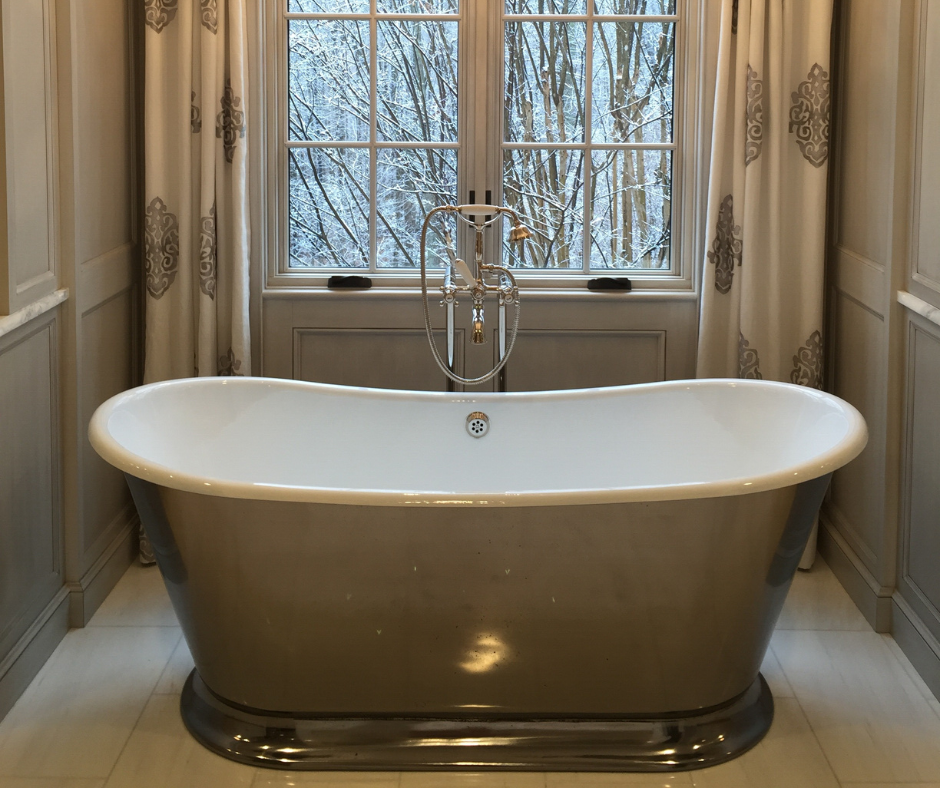
Architects and builders have responded to this interest by allocating more space and more design expertise to bathrooms in newly constructed houses. Bathroom designers, architects, and renovation experts have become skilled at reshaping existing bathroom spaces into more spacious, stylish, and exciting rooms.
The purely functional approach towards baths by earlier generations has been replaced by one that obviously still puts a premium on function but has tangibly and dramatically elevated the level of design. Decorators and architects now have access to a growing number of resources with which to create marvelous spaces. The availability of recessed lighting, for example, allows us to incorporate a sense of drama not available to our parents. New developments in flooring, tile, and window design also add to the options available for shaping the look of our bathrooms.
The bath is an essential and important room in the house. To help balance our busy agendas, a stylish or simply soothing bathroom can enhance our lives immeasurably. I hope this blog gives you a checklist to build the bathroom of your dreams.
Planning Your Bathroom and Steps to Consider:
Before you remodel your bathroom, sit down and thoroughly plan what you want for yourself and your family. Be sure to resolve your expectations during the planning stages, not during construction or after the room is finished. This will save you a lot of aggravation and money. Mistakes are costly and in bathrooms, the fixtures-sink, tub, toilet, and shower stall are placed to be permanent. In the living room you can move a chair if you change your mind. In the bathroom, you cannot move the tub without spending considerable money. Pictures below to show just how much work can go into installing one!
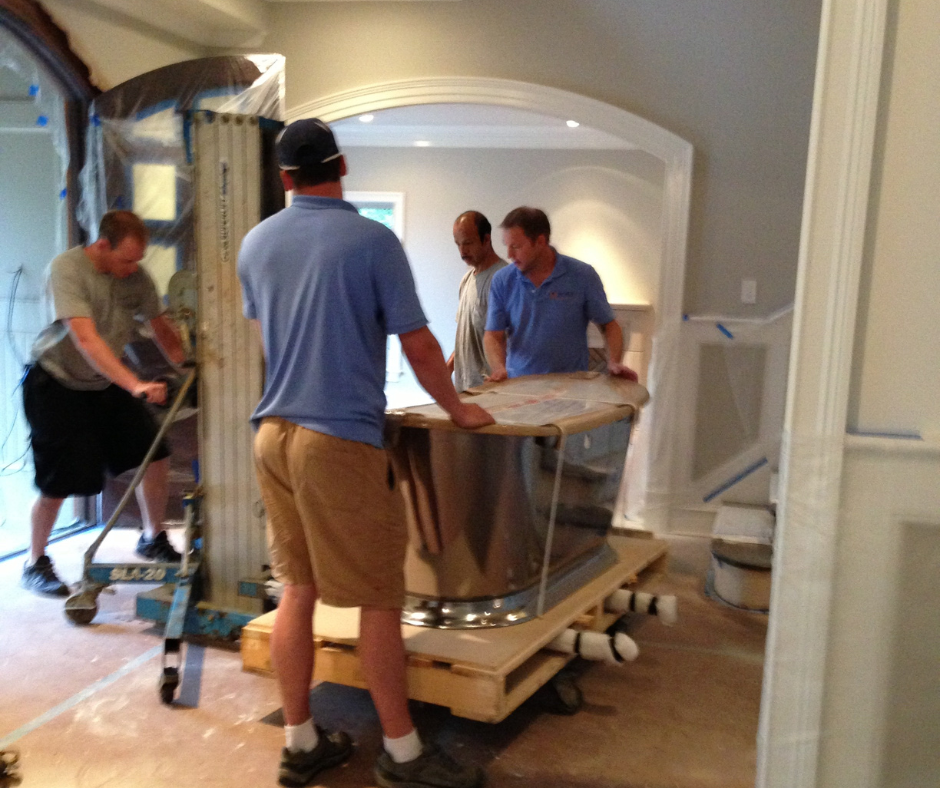
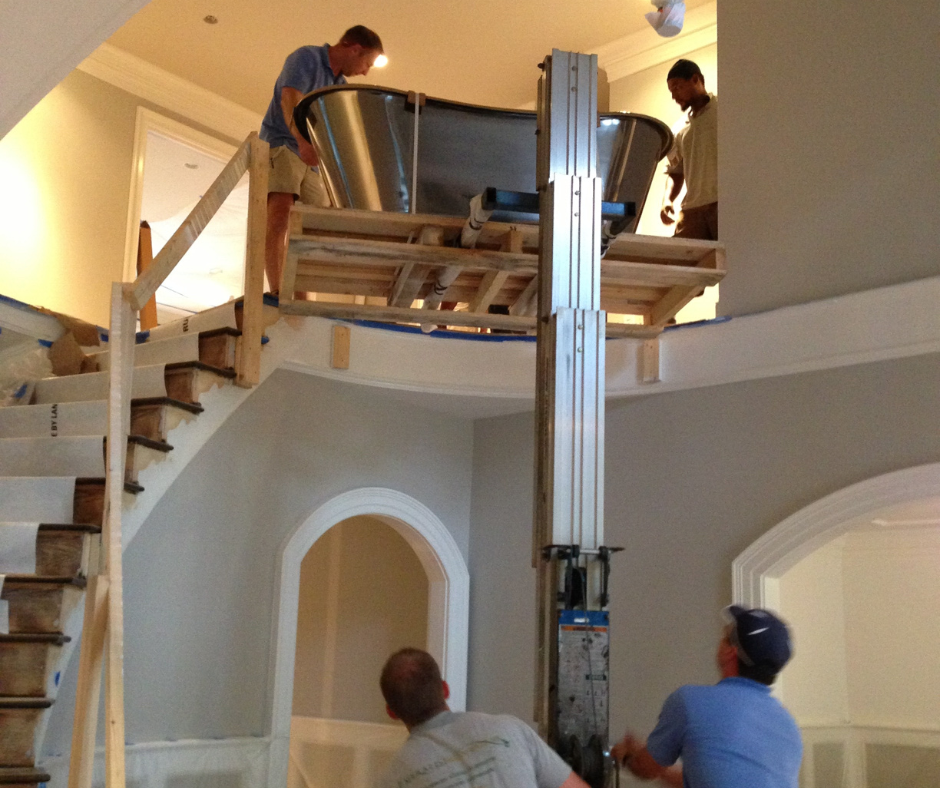
Here are the steps to follow in the planning stage, before any work is done:
-
Measure and Map
Measure your bathroom and note the locations of the fixtures: tub, toilet, sink, and shower stall. Ask yourself these questions:
- Are you pleased with the locations?
- Is the circulation pattern in the room convenient and safe?
- Is there ample space for linen storage?
- Is your sink large enough to wash your hair?
- Is your towel bar located in a convenient spot?
- Is your vanity large enough to hold all your toiletries?
With a piece of graph paper and a straight edge, make a floor plan of the bathroom, using the ratio 1 inch equals 1 foot. This will avoid confusion and miscalculation. Show the overall size and shape of the space. Note the location of the doors, windows, skylights if any, architectural elements columns, fireplaces, built-ins and fixtures.
-
Pros and Cons List
Take a piece of paper and divide it into two columns. Head one column Pluses, the other Minuses. On the Pluses side, list all the elements of your bathroom that you like. These can be anything from the fixtures to the convenient towel storage cabinet located next to the sink. On the minus side, list all the things about your bathroom that you do not like, for example: chipped, stained, outdated, or ugly fixtures, unappealing tiles, cramped or inefficiently used space, or anything else that makes you cringe every time you enter the bathroom.
-
Analyze the Feel and Flow
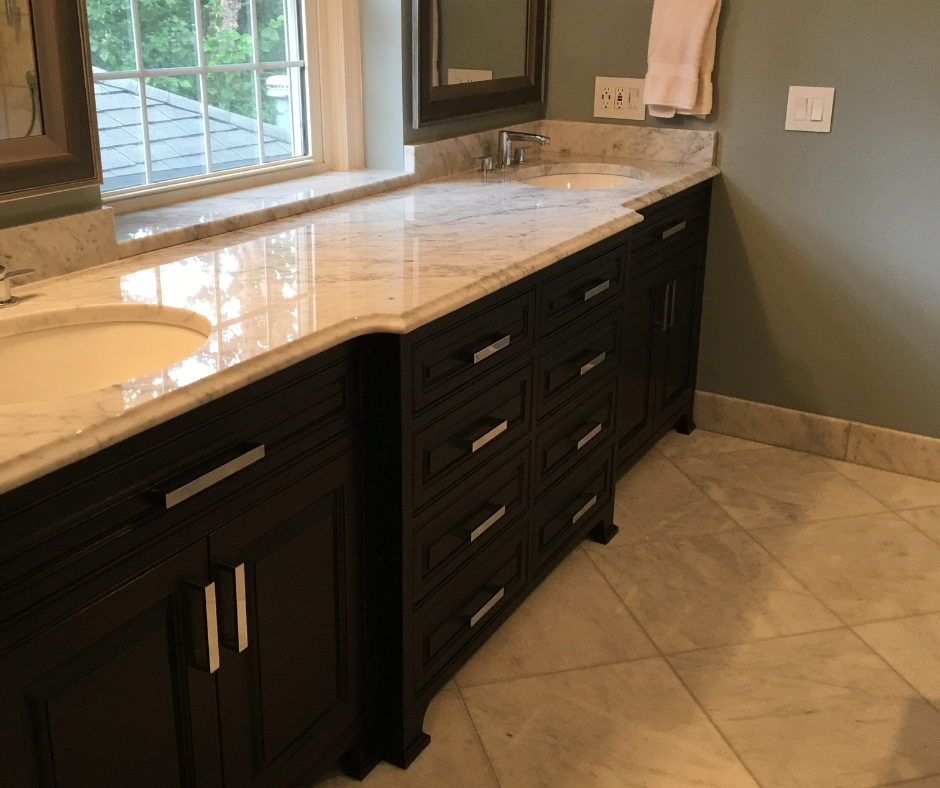
Now that you have all of the things you like and dislike listed, analyze the flaws and consider what could be done to correct them.
- Is the lighting poor?
- Is the tub located in an awkward spot?
- Is the room claustrophobic when you close the door?
Note these things as well.
-
Consider your Personal Preferences
Decide what type of bathroom is appropriate for your lifestyle.
- Do you spend a lot of time bathing in the tub?
- Do you want a bathroom that can be a combination space – exercise room, dressing room, private retreat, spa?
- Do you have small children? Is your bathroom going to be a decorative powder room or is it the main bathroom for the entire family?
Once you have decided what you want your bathroom to be, write it down.
-
Consider Trends and Resale Value
Now that you know what you personally want, before you turn it into a beautiful homage to the Taj Mahal, or decking out the entire bathroom in only black marble, consider what are trends, and what are personal preferences that may reflect poorly on resale value. Lifestyle and taste work together to create the perfect bathroom for you. Decide what appeals to your sense of style but remember that trends come and go, so carefully consider color choices, fixture styles, and accessories before having them installed in your bathroom. Bear in mind that a home’s resale value is strongly influenced by the bathroom. If your favorite color is, for example, blue, consider selecting neutral color tiles and fixtures and painting or wallpapering the walls blue. A potential buyer can easily envision painting or wallpapering the walls in another color, whereas a blue tub, toilet, and tiles might well discourage a sale. Only you know how much personalization makes sense based on your future plans, so ensure you’re considering all sides!
-
Consider Your Budget
Based on your resources, carefully consider how much you can afford to spend. With that number in mind, determine a plausible maximum amount. A few statistics to consider in this area include that most renovations run 20% to 30% more than anticipated, so plan your budget with this in mind. Also, remember that you never fully recoup the total cost of the renovation. In
Northern Virginia, generally you can expect to recover approximately 75% to 85%, depending on the current market value of homes in your neighborhood, so don’t expect to easily flip your home based on these improvements, especially if you are personalizing the bathroom.
-
Consider Your Team and Get an Estimate
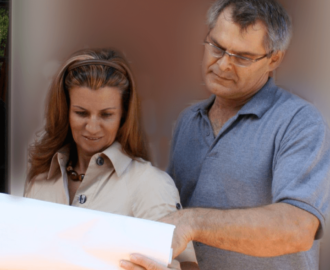
When renovating a bathroom you need to find the appropriate professional to execute the remodeling. Bathroom remodels can require contractors, plumbers, electricians, cabinet makers, and/or painters based on the project. Because of all the people involved, you’ll likely want to first consult with an interior designer to ensure everything works together, and some are also project managers and can manage all the other professionals mentioned. When you discuss with the designer, bring your floor plan and wish list and let the professional assess whether your ideas are viable. Armed with this information and your budget guidelines, you should be able to get an estimate.
-
Set a Timeline
Once an estimate of the work has been given and approved make sure to agree on a timetable. Be realistic and remember that every project runs into a snag or two, so allow yourself some extra time. Especially if you have an older home, add extra time as there are far more things that can become an issue than with new construction.
Additionally, this point may seem obvious, but is sometimes overlooked! Be sure that while the work is being done on your bathroom you have another one available to you. If work is being done in your only bathroom, prepare to live somewhere else for a while. No matter how much you mentally prepare for in-house construction, you will feel displaced, invaded, and frustrated during the weeks it is going on. Don’t despair, when all the work is completed your dream bathroom will be a reality.
Now that you understand the flow of how a project, like a bathroom remodel in Northern Virginia should go, let’s discuss more of the practical areas and smaller pieces of the puzzle not to be forgotten!
A Bathroom for All:
Making Sure Your Bathroom Is Useful in the Future:
Designing your bathroom creates a variety of challenges and opportunities. Many people think about color, taste, trends, lifestyle, location in the home, and usage, but never consider this room’s usefulness in the future. Do not fall into the trap of designing only for the present. For example, many people do not need a bathroom that is wheelchair accessible. However, we all grow older, or we may have to care for an elderly parent or a handicapped family member. It makes sense when redesigning your bathroom to incorporate the following objectives into your plan:
1 – Circulation
Wider doorways provide easier circulation. Most accidents that occur in a home, occur in the bathroom.
2- Grab bars
Every bathroom should incorporate a grab bar in the tub and shower area. It will provide needed support for older bathers, young children, injured family members, and anyone assisting with the care of others.
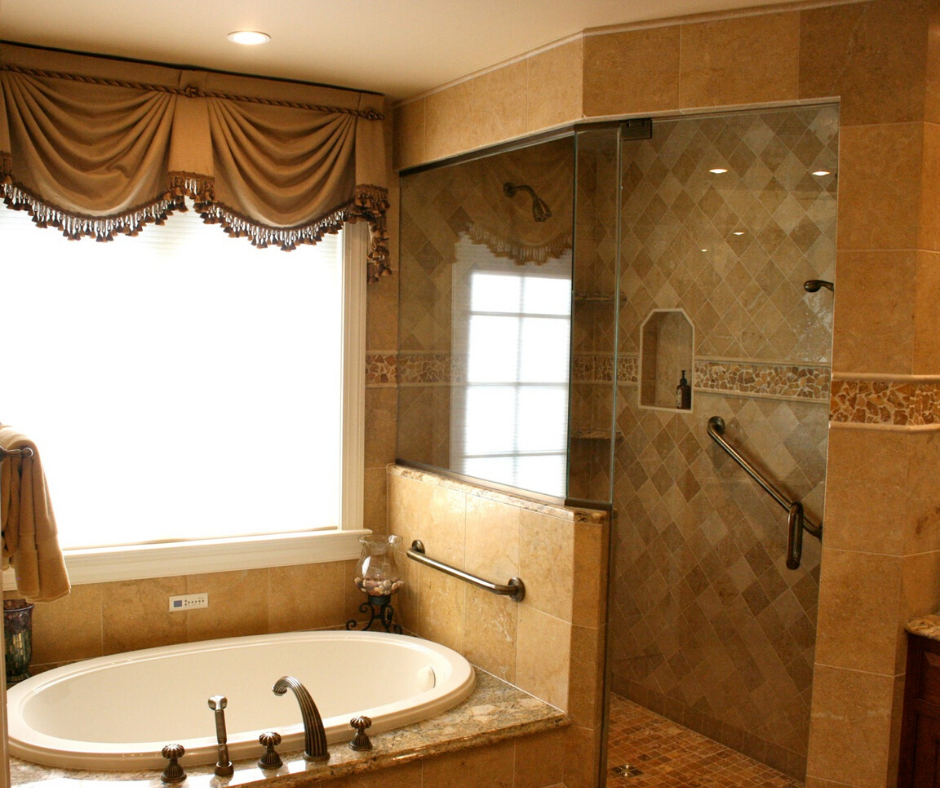
3- Adequate lighting
Besides ambient or mood lighting, proper task lighting is an absolute must for the bathroom. If your lighting is too dim or insufficient for your family, change it.
4- Faucets, towel bars, and accessories.
Before purchasing anything for your bathroom, carefully consider who is going to use the space. If you have small children or elderly parents, for instance, delicate, or ornate faucets are not the right choice. Fixtures are available with colored markers for young children who cannot read or individuals with limited vision. Avoid toilet paper or towel holders with sharp edges. Make sure scatter rugs are securely anchored to avoid trips.
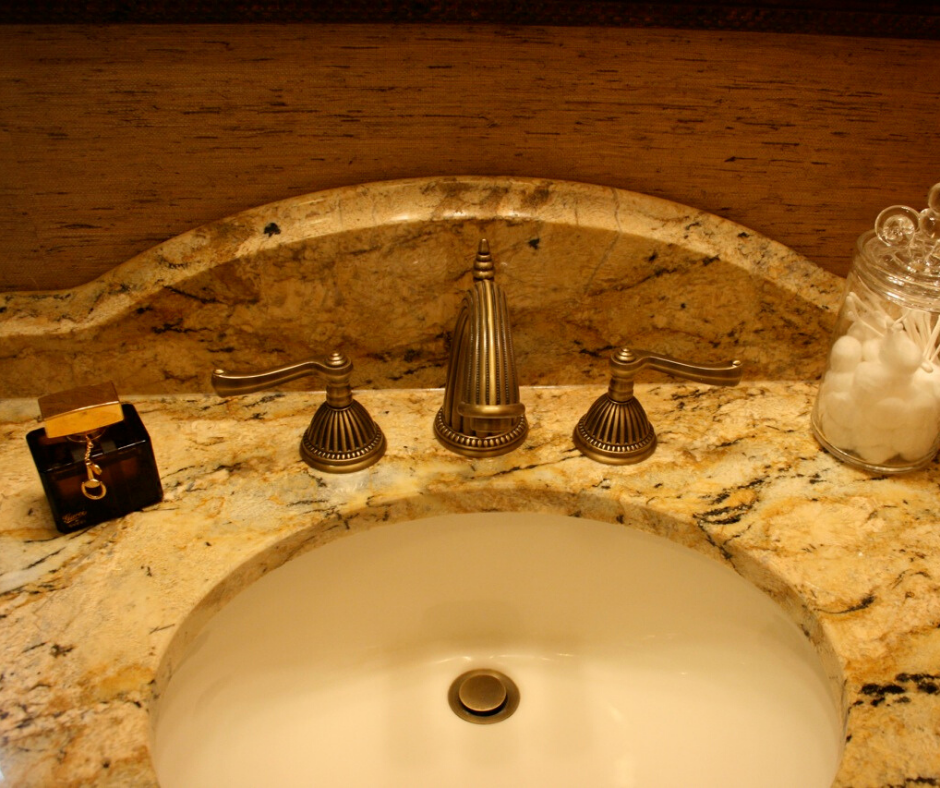
5 – Potential hazards
Store all medicines and razors in an area that is away from small children. Electrical outlets should be locked or child proofed to avoid shock.
With the average age of Northern Virginia residents at 39, it’s clear there is a mix of people with children and/or elderly parents living at home, so even if you do not have these current needs, remember that you may in the future and it will help with the resale of your home.
Bathroom Parts and Trends We are Seeing in Northern Virginia:
My favorite part of being an interior designer in Northern Virginia is seeing how every client takes their personal preferences and mixes them with all the factors we’ve discussed up to this point, to create the perfect space for them. Each bathroom is like a puzzle needing to be solved to perfectly suit our clients. Having been inside and worked on hundreds of bathroom remodels throughout Northern Virginia, here is a rundown of all the trends we’ve seen in the last few years:
Sinks
Pedestal Sinks
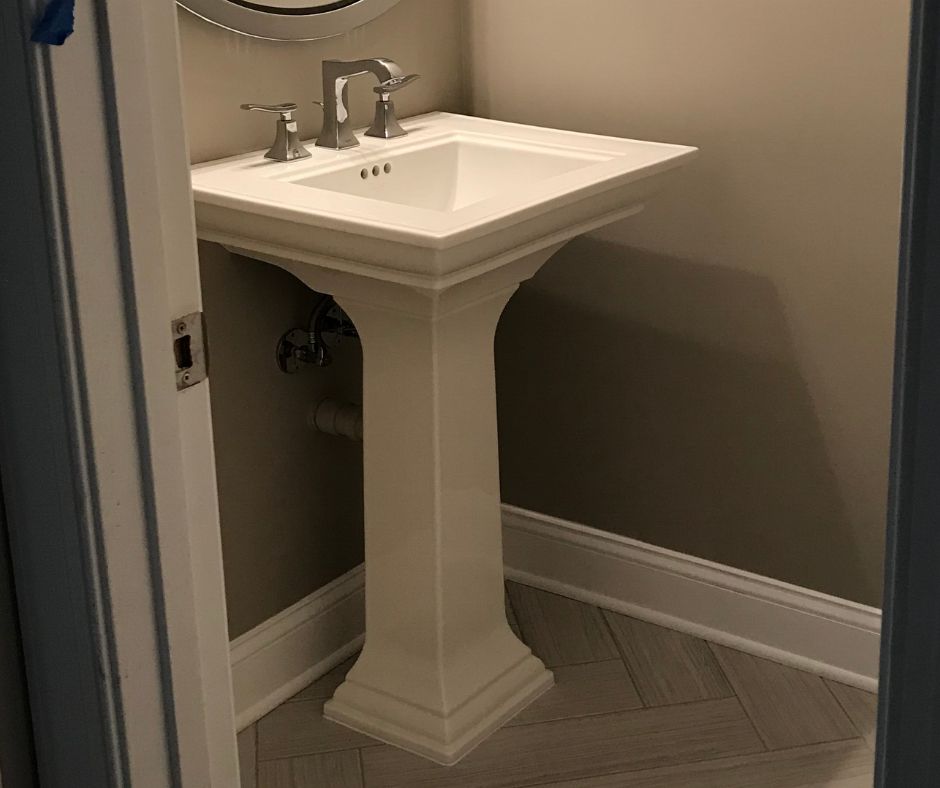
Pedestal sinks are freestanding sinks that are supported by a column underneath. These types of sinks are without a vanity and are wonderful to use when you do not need storage space. Pedestal sinks are excellent to use in a small bathroom because they don’t take up a lot of space. We’ve seen these used quite often in half-baths and small bathrooms in row houses in Alexandria.
Vessel Sinks
Vessel sinks sit on top of a vanity and come in a variety of shapes and sizes. They are made from a variety of materials. Porcelain, glass, metal, and marble to name a few, tend to be found in bathrooms that are not used as frequently, like powder rooms. Vessel sinks are hugely popular and provide wonderful eye candy to any bathroom.
Drop Sinks
Drop sinks are usually made of porcelain and can be lowered or dropped into the countertop. The rim of the sink extends so that it rests on the counter and carries the weight of the sink. This is the ultimate go-to sink anytime you are using a vanity base.
Under Mount Sinks
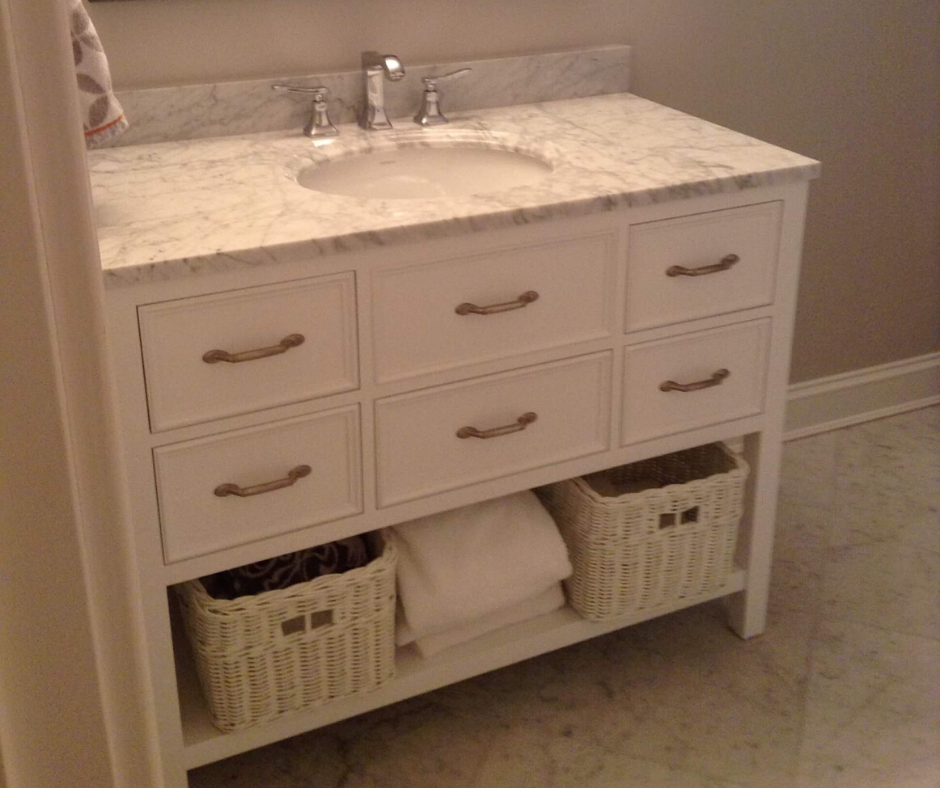 These are common in both kitchens and bathrooms. Countertops are templated and the holes are cut to match your sink shape, soap dispenser, and faucet. The sink is then installed under the counter using epoxy and brackets. Usually, your granite installer can make all the necessary templates and cuts and do the install….everything except the plumbing. (As we mentioned, it’s always easiest to work with an interior designer that can project manage all these aspects for you!)
These are common in both kitchens and bathrooms. Countertops are templated and the holes are cut to match your sink shape, soap dispenser, and faucet. The sink is then installed under the counter using epoxy and brackets. Usually, your granite installer can make all the necessary templates and cuts and do the install….everything except the plumbing. (As we mentioned, it’s always easiest to work with an interior designer that can project manage all these aspects for you!)
Faucets
When starting your search for the perfect faucet, you will be amazed at the broad range of styles and finishes. When choosing a faucet for your new bathroom, there are three main considerations, style, function, and fit.
Style
If you have a passion for a more modern look, the single hole faucet may be your best bet. In satin nickel or chrome, these faucets add a sleek look to any bathroom. If you are going for a more traditional look, a three-hole faucet may be your best bet. Like a single hole faucet, they come in the cooler metals like chrome and satin nickel but they also come in oil rubbed bronze or antique brass, finishes that give an old-world look. Brass is a finish that is trending or making a come back. We went for years without seeing brass fixtures now clients are wanting that warm metal look brought back into their bathrooms.
You can also choose the three-hole faucet according to the handles you prefer, which can either be straight for a more modern look or curved for a more traditional look. For bathroom remodels in Northern Virginia, we’ve seen both the traditional and modern looks equally and as a transitional interior designer, I also find that typically NOVA residents go for more modern fixtures in their bathrooms and kitchens than in the other rooms of their homes.
Function
Before choosing a faucet, consider the use it will receive. If you have children and a bathroom that gets a lot of traffic, you may want a sturdier, heavy-duty faucet. If you are buying a faucet for an infrequently used powder room, you may want a faucet that is more decorative.
Fit
If you are planning a bathroom renovation and are designing the vanity and countertop it may be that the sky’s the limit and your choices are endless when it comes to a faucet. If you are replacing the faucet because of breakage or just wanting to update the look, always measure to determine how the holes in the countertop are set.
Tubs:
My favorite area of a bathroom is the tub! Here is normally where I see the gender divide with my clients, as most of the NOVA women are interested in the tub more than their male counterparts. The kinds to consider are:
Standard Tub and Shower Combination
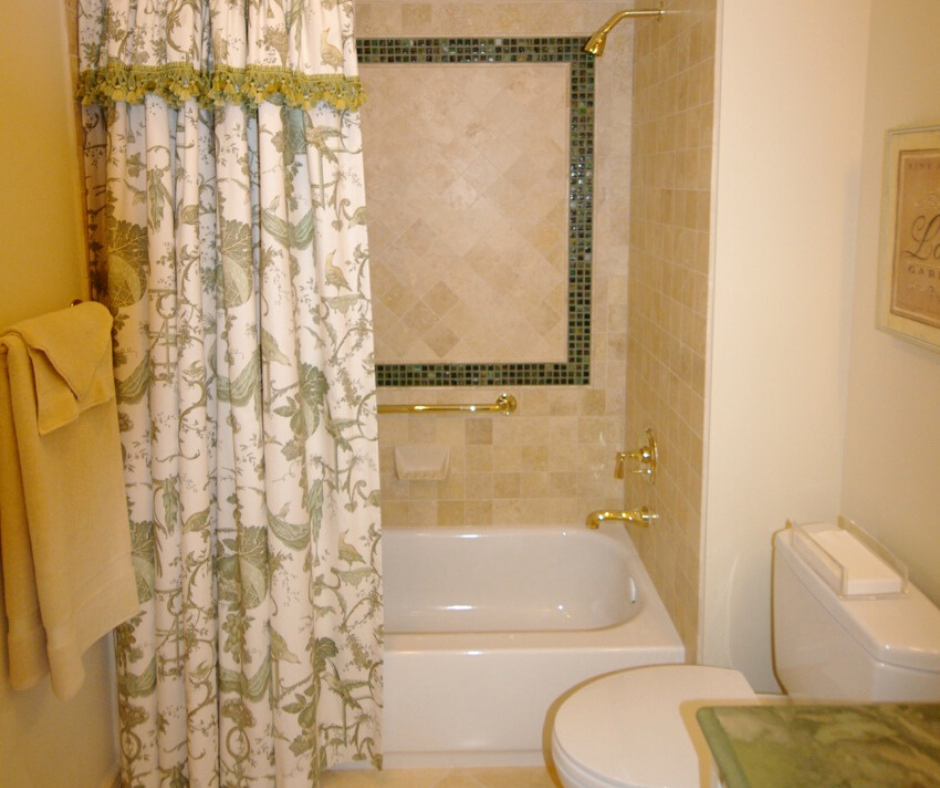
This combination is the most common type of bathtub and can either be enclosed with sliding glass doors or a rod with a shower curtain. It is very practical for smaller spaces.
Freestanding Tubs

These are designed to stand independently anywhere in a room and are often the focal point of the bathroom. All sides of a freestanding bathtub are typically finished and accessible. Faucets are installed as freestanding floor units are into an adjacent wall. They may be able to integrate a shower, but it is not something I typically see. They come in a variety of designs, including flat bottom, pedestal, or clawfoot and finishes such as acrylic, fiberglass, porcelain-enameled cast iron or steel, copper, or stone resin.
Drop-In Bathtubs
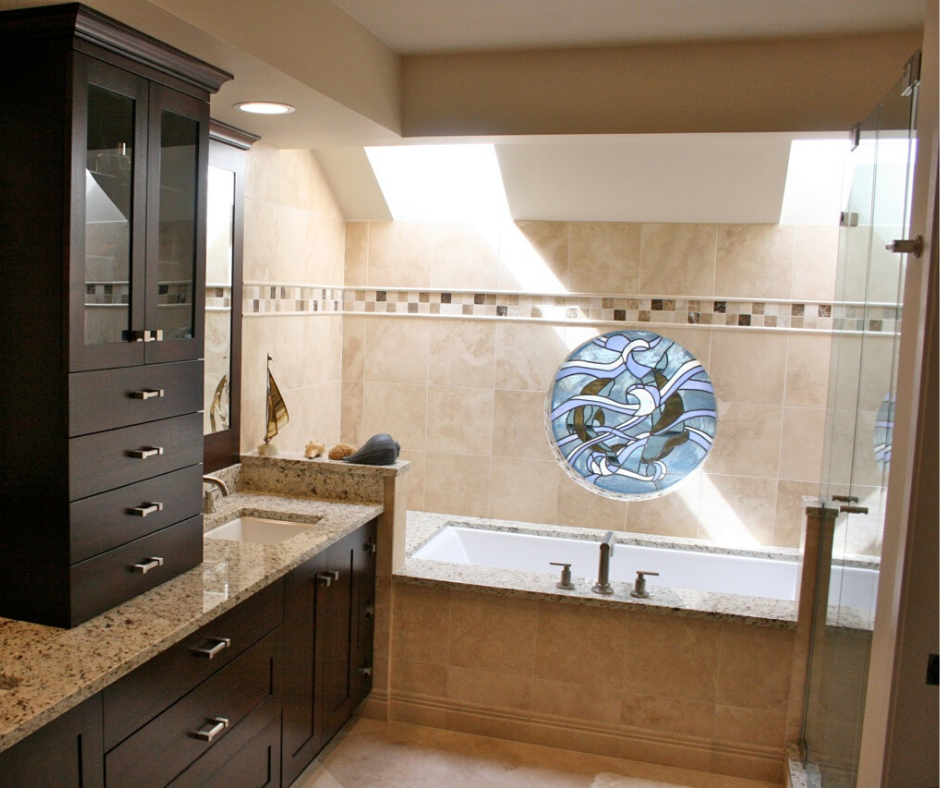
Designed to be dropped into a pre-built deck or surrounding walls. All four sides are unfinished but feature a room that sits on top of a platform material. Drop-in bathtubs offer versatile placement possibilities. They may require extra work to install and a larger upfront investment. They will also need a kit for under-mount installation. We find that these make the most sense when you have a dedicated area in your bathroom for the tub that does not allow it to be accessible on all sides.
Shower Enclosures
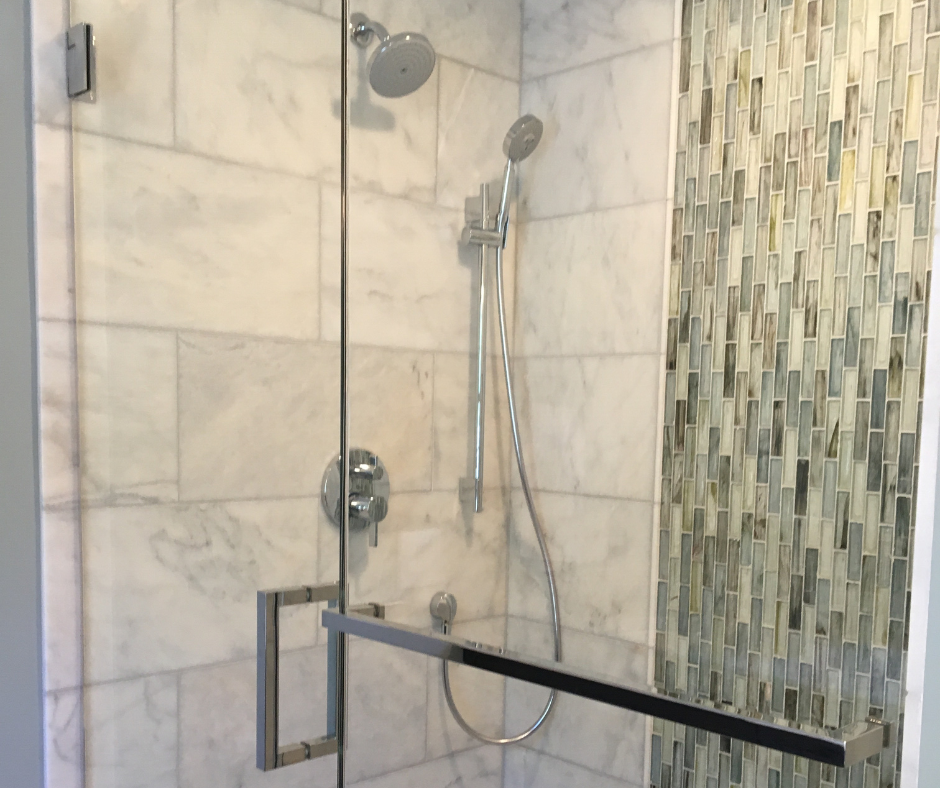
Frameless shower door enclosures are the most commonly used in the industry right now. Made up of 3/8” to 1/2” tempered and polished safety glass. This glass has greater strength and does not require heavy metal framing around it. Frameless shower doors last much longer than a framed shower door and eliminate ugly thick metal framing.
Toilets
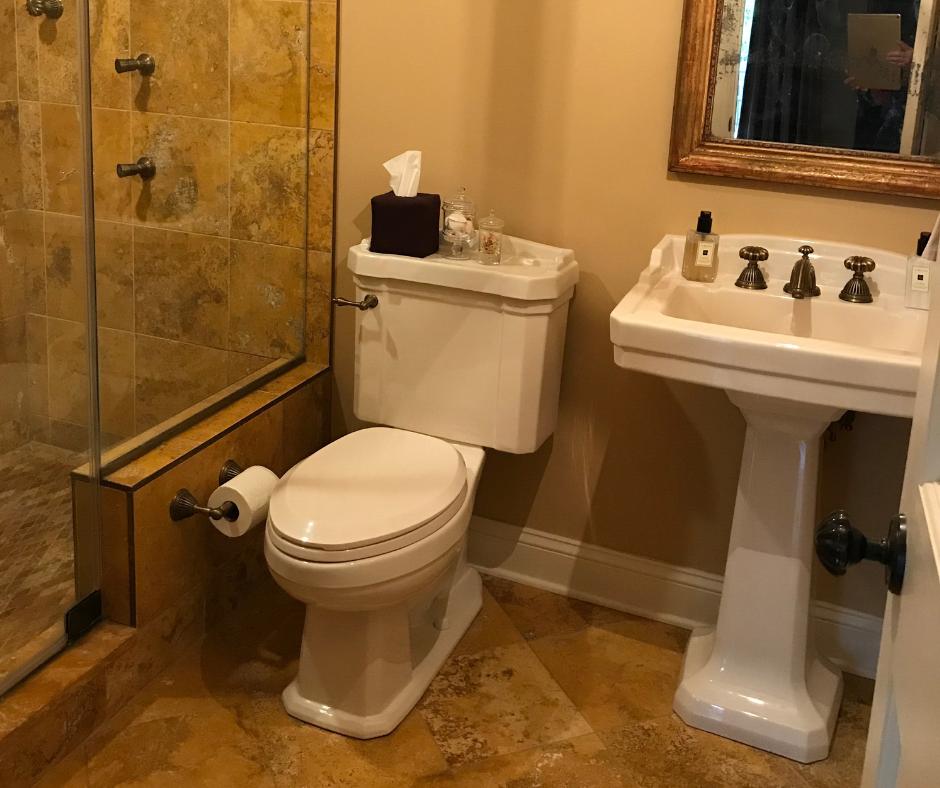
One of the most overlooked, but important parts of the bathroom are the toilets. When undergoing a bathroom renovation, make sure that you know your options and the different functions of toilets. There are one-piece toilets and two-piece toilets and each are constructed differently. When choosing between two-piece and one-piece toilets, you need to have a clear understanding of how they work.
Parts of the Toilet
Every water closet consists of three main parts: a tank, a bowl, and pedestal. The pedestal ensures that the toilet has the optimal height. The tank stores a certain amount of water while providing the necessary flushing power to keep the bowl clean. In addition to collecting the waste, the toilet bowl ensures that the waste finds its way into the drain pipeline. When it comes to traditional one-piece toilets, the tank and bowl are fused together with no joints. Two-piece toilets feature the construction where the tank and bowl come separately, they can be joined with fittings.
Types of Flush
There are single flush toilets and dual flush toilets. Single flush toilets can be found in most older homes and deliver the same amount of water per flush regardless of the type of waste. Dual flush toilets, on the other hand, offer two separate flushing options. A full flush is intended for solid waste, while a half flush is aimed at disposing of liquid waste. The idea behind this interactive design is to help save water.
Cabinetry
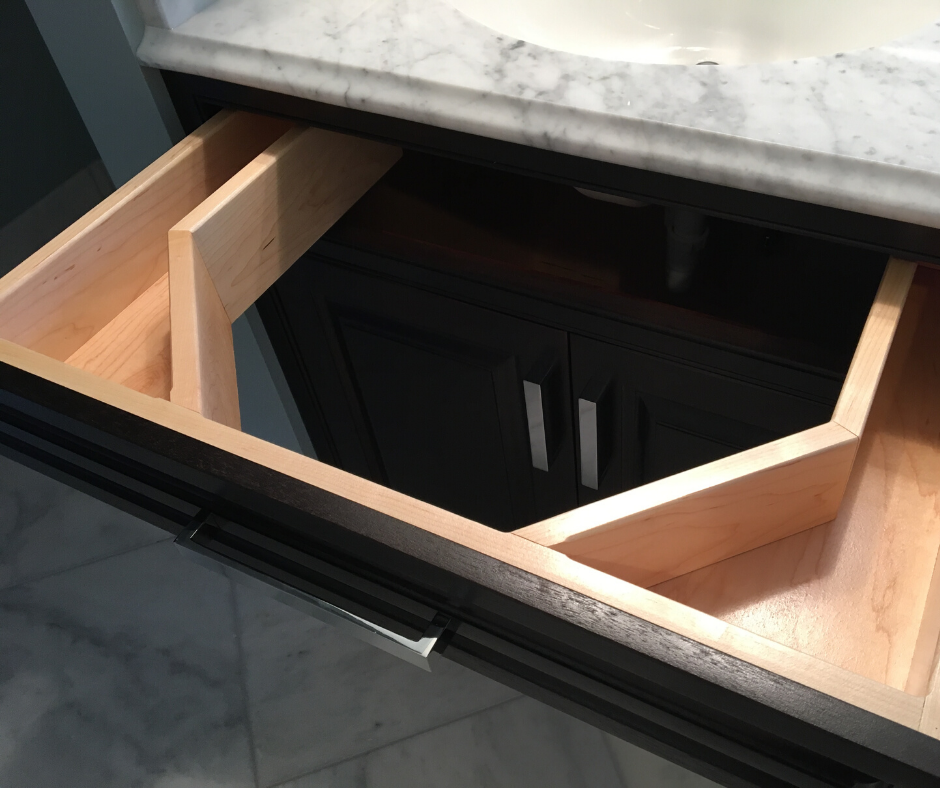
In having your bathroom vanity custom made, it gives you the availability of choosing the exact size that is perfect for the space. You get to customize the inside of the cabinet, the drawer space, and shelving. All of this is very important when you live in a small house and need extra shelving for linens or cleaning supplies, or if you have specific routines and a lot of specific bathroom products. Another plus for having your vanity custom made is you get to choose the stain color or paint finish. This is a wonderful option to have especially when you are trying to match the colors to an already existing color scheme.
Tiles:
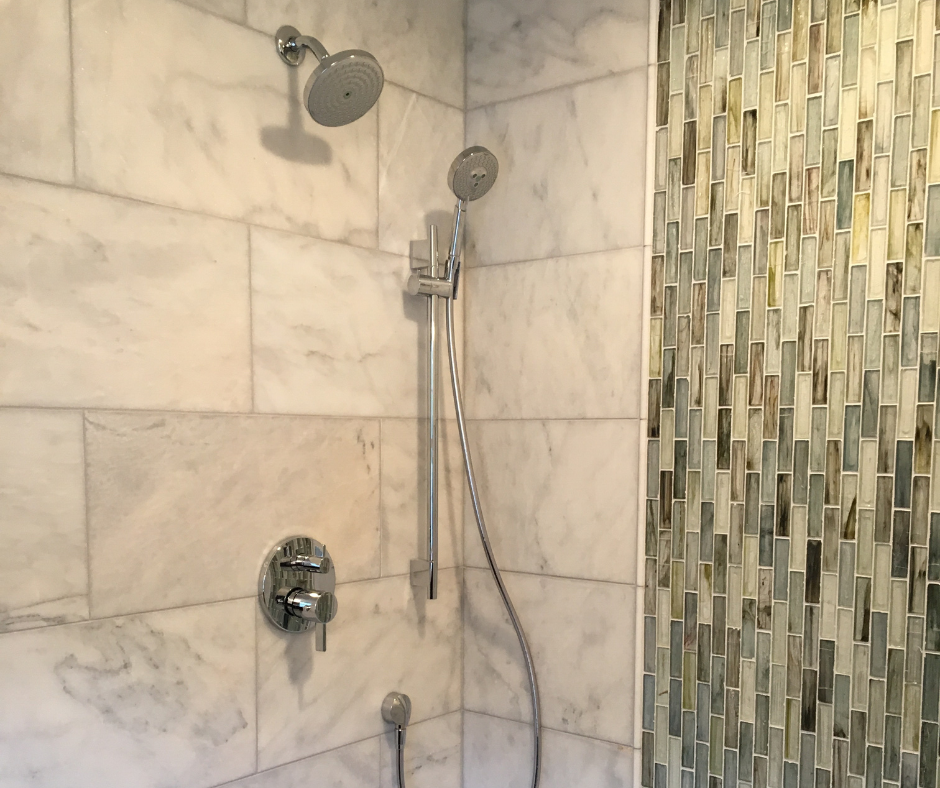
The possibilities that exist for the actual materials that you use for your floors and walls are endless. Two of the most popular choices are ceramic tiles and marble. First, the more common product for a bathroom floor and walls is ceramic tile. Made from clay or silicates which are fired at high temperatures. Marble is a natural stone caused by the metamorphic crystallization of limestone which converts calcium carbonate into calcite crystals. Both can look lovely in a bathroom and vary in style.
Classifications
Ceramic tiles come in many forms, such as quarry tiles, terra-cotta, porcelain, and even glass. Marble is also available in a wide array of colors and shades resulting from the geological processes that form the stone.
Variations
The color and appearance of ceramic tiles is carefully controlled during the manufacturing process resulting in a product with minor variations between lots. Marble, however, is a product of nature. There can be wide differences between different lots of the same stone. This is important to consider if you want to marble a large area, as it is far more difficult to match and create continuity across the space.
Finish

Ceramic tiles come both glazed and unglazed. They usually have some type of pattern screen printed on their face to mimic the look of natural stone. Marble typically comes in a polish finished, honed or tumbled. The type of finish you want will vary based on where the tile is going. Areas that receive lots of water should have a different finish than those that are for counters.
Lighting
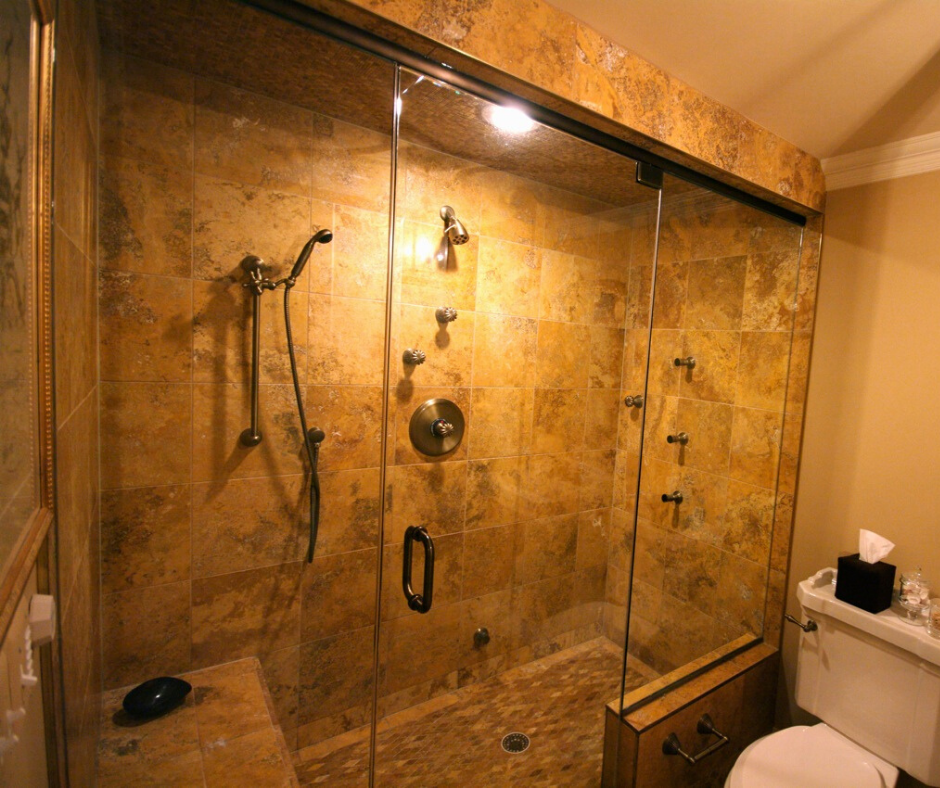
The lighting plan is one of the first things to discuss when renovating a bathroom. Recessed is a great option and can add both function and style to the bath space helping to create an area that is easy to unwind and unlike regular wall sconces or ceiling mounted decorative light fixtures, recessed can also be installed in wet areas such as shower stalls.
Decorative lighting or task lighting is another favorite and always adds to the look of a bathroom along with recessed. Scones for instance on either side of the vanity mirror or over the vanity bar lighting can add much-needed light. If you have a freestanding bathtub, opt to hang a wonderful chandelier which adds elegance and ambiance to space.
Accessories
Towel bars, toilet paper holders, robe hooks, soap holders, and trash cans are all much-needed accessories but designing your bathroom is ultra-important when planning out the space. If you have artwork that you know you want to place in your bathroom make sure and measure the wall space ahead of time. Proper planning is the only way you will achieve a beautiful bathroom.
Overall the bathroom is a very personal space, so each aspect should be considered for your needs and having a designer that can help ensure you make the right decisions for your personal preferences, functionality, and resale value can be very important!
Resources in Northern Virginia
Living in the DC area we are lucky to have several sources for stone, lighting, and other accessories that make the process simpler and give wonderful options. I’ve put some of my favorites below.
Sources in Northern Virginia
Below are some of our favorite sources in Northern Virginia for bathroom remodels followed by notes on what we find from them:
Marble Systems – tile and marble
Mosaic – tile, marble, lighting, and plumbing supplies.
Neka Granite – slabs of marble and granite.
Fergusons – lighting, plumbing supplies and accessories.
Waterworks – lighting, stone, faucets, and accessories.
Dominion Electric – lighting.
Interior Designer in Northern Virginia
We are an interior design and renovation service provider for Northern Virginia and would be delighted to discuss your next bathroom renovation project with you! With many talented designers out there, we are well placed to help you since we completely focus on Northern Virginia and the DC area with excellent contacts of master craftsmen and sources for bespoke finishes in your home.
Conclusion:
Before you jump into a bathroom remodel in Northern Virginia there are a lot of things to consider! I hope this guide has helped you better understand the scope of your project, what we are typically seeing in the area as far as trends go, and the best ways to execute your remodel without going over budget or having major issues along the way. Please get in touch should you like to discuss your project with us further.

